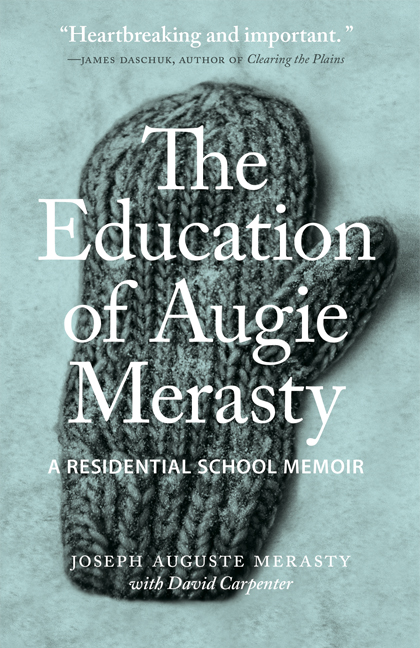Chip in to keep stories like these coming.
The Education of Augie Merasty: A Residential School Memoir might be a small book, but it carries a punch to it that all Canadians need to read and understand: a firsthand account of the impact residential schools had on Indigenous children forced to attend, told by a young boy, Joseph (Augie) Merasty, and how this experience shaped his life.
Indian Residential Schools have played a long, sad and harmful history in Canada since they first opened in the 1840s until the last one closed in 1996. Merasty, one of 150,000 children taken from their families during this era, was taught to be ashamed of his family and his culture, and experienced emotional, physical and sexual abuse that no child should ever have to experience.
It is through survivor’s stories like Merasty’s that the general public learned of the abuse and other atrocities that happened at these schools.
Merasty, an 86-year-old Cree man, began to tell his story after being inspired to write by the Working Group on Truth and Reconciliation and of the Exploratory Dialogues in the 1990s. He wanted his story to be told and known so that the abuse and terror Native children endured during the residential school era would never occur again.
Merasty began handwriting his stories and account of the abuse he endured at St. Therese Residential School in Prince Albert, Saskatchewan and sending them to author David Carpenter.
Carpenter was tasked with transcribing the long and lengthy letters Merasty wrote into this memoir, and he does a great job in taking readers into Merasty’s time at St. Therese Residential School and subsequent years afterwards.
Merasty isn’t the first in his family to go to residential school. Two of his sisters and his brother Peter were the first three to walk inside the school. There were also six uncles and the same number of aunts who attended the school in its first year.
According to Merasty “All those sisters and cousins, uncles, and many other unrelated people from other villages told me what had happened. Good and bad, positive or negative, were told to me and others when we got to school eight years later and they all told basically the same stories. So one has assume they were speaking the truth and nothing but.”
Merasty’s first memory is being taken to St. Therese Residential School in 1935 when he was a mere five years and eight months old. The school was a long journey from where he lived in Sturgeon Landing, Saskatchewan, so though he was not of school age yet, his father made an arrangement with the head administrator and principal Father Aquinas Merton for Merasty to attend school.
Merasty recalls “due to the distance from the residential school and the need to travel in winter by dog team in extremely cold weather, it would be very hard on a six-year-old child just to take him to St. Therese School. And that winter my father and family had decided to go way up north to trap. So they took me to school at the end of the summer when I was still five years old.”
While in school he endured cold, hunger and beatings, not to mention sexual assaults at the hands of a nun. Mixed with the stories of abuse are accounts of the occasional nice teachers Merasty encounters at school, for example his first class teacher Sister St. Alphonse, who Merasty says was “one of the kindest and most loving persons in that institution.” He speaks of her with love in his words as he relays how she was the boys keeper in his playroom at the time and joined them in playing Hide and Seek the Marble and other games they enjoyed.
In other accounts he writes of the hard times that he endured, and how he and the students enjoyed going out miles away from the school, going on picnics or fishing because it meant they could leave the enclosed playground.
He states “Most of the time, we were forced to stay within the yard, which was surrounded by high barbed-wire fence. It felt like getting out of prison,” and he recalled many times he was detained and not able to join the crowd going on these outings especially if he was being penalized for minor offences such as “whispering during silence, or poking someone in the ribs, or swearing in Cree,” which was an absolute no no considering they were not allowed to speak their language in any way.
It was at St. Therese that he began a journey that would last him a lifetime to heal from.
“All I have stated about incidents regarding our keepers at St. Therese are absolutely true, and I can write a lot more that transpired inside and outside of school. But here I have endeavoured to put down mostly things that would have had a devastating impact on many boys after leaving the school and I myself noticed through the years how it affected some, including me,” says Merasty.
He continues, “Lastly I sincerely hope that what I have related here will have some impact, so all that has happened in our school, and other schools in all parts of Canada — the abuse and terror in the lives of Indian children — does not occur ever again.”
The Education of Augie Merasty: A Residential School Memoir is a heartbreaking but important read for everyone if they truly want to understand what went on in the residential schools.
Christine Smith (McFarlane) is a Saulteaux First Nations woman, who hails from Peguis First Nation. She is a published writer and freelance writer for Anishinabek News on a regular basis. She has also contributed to other newspapers such as the Native Canadian,The Native Journal, Windspeaker, New Tribe Magazine, and FNH Magazine. She is a contributing editor with Shameless Magazine, and a contributing writer for the Toronto Review of Books.



